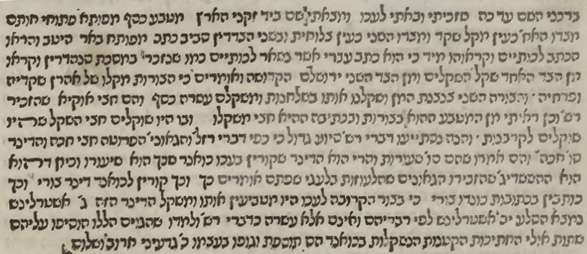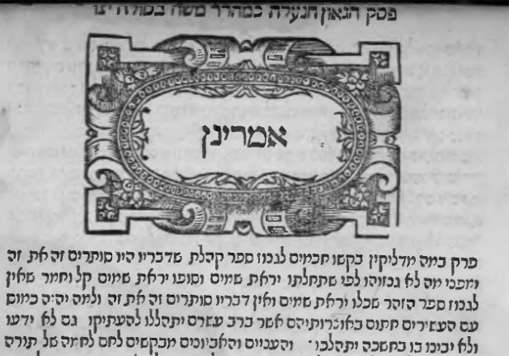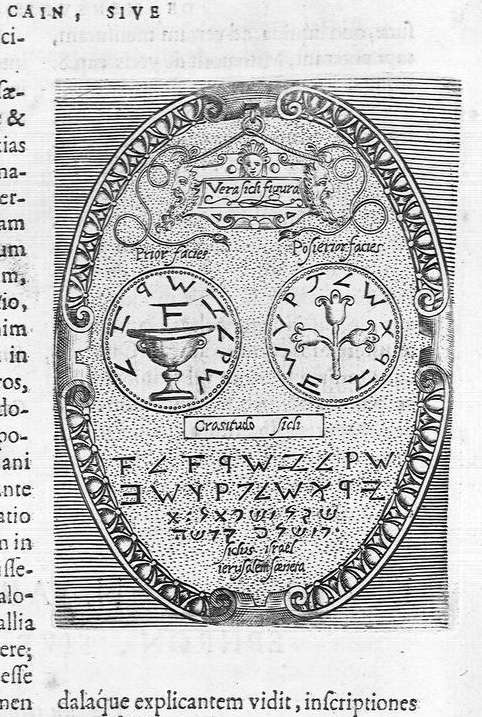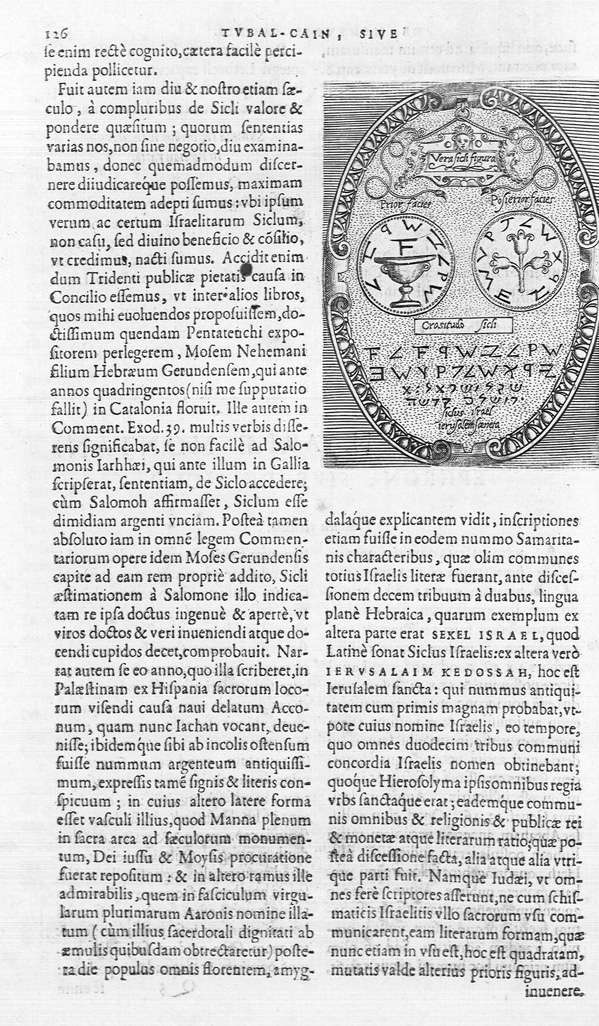
In Acre he learned that some elders possessed an ancient silver coin. Engraved upon one side was a branch of an almond tree, and on the other side a jar. There was some writing on both sides. Unable to decipher the script, they showed the coin to some Samaritans who could read it without hesitation, since the ancient Hebrew script is used by them, as mentioned in Tractate Sanhederin. On one side it read שקל השקלים, sheqel of sheqels, and on the other ירושלם הקדשה, Holy Jerusalem. The Samaritans explained that the branch is the rod of Aaron and the jar is the jar of manna. Weighing it on a scale, they were able to see that it weighed 10 pieces of silver, which is equal to half an ounce, as indicated by Rashi. He also saw a coin with the same emblems which weighed half the weight of this coin, which could be used to weight out the amount used for the sacrifices.
However, in the commentary itself he had questioned Rashi's measure (Exodus 30.13):

Rashi wrote (Exodus 21.32): "A sheqel weighs four gold coins, making half an ounce according to the correct weight of Cologne." This is based on the Gemara, which gives such an equivalence (i.e., gold and silver denars had the same weight). Ramban goes on to cite sources which assert that gold coins no longer weighed what they once did, while Rashi seems to be assuming that the weight remained constant (and that is why he cites the gold coins of Cologne). According to the Halakhot Gedolot and the Rif, "our" gold coins are almost a third smaller than those in the time of the Talmud. They therefore opined that a sheqel would weigh 3/4th of an ounce, and this is the opinion Ramban seems to accept. However, his later experience with what seemed to be actual sheqalim show Rashi to have been entirely correct.
(Both images are from the 1490 Naples edition.)
This passage became quite famous to anyone interested in what the ancient shekalim, as well as the ancient Hebrew, looked like. Rabbi Azariah dei Rossi quotes this passage in the 56th chapter of Meor Enayim, which is titled על האותיות של כתב עבר הנהר ושקל הקדש. The book included engravings of a table of the Samaritan alphabet as compared with the Hebrew, and copies of both sides of such a sheqel as described by the Ramban (see here). What were his source for these images?
For the alphabetical table, de Rossi writes:

He had thus seen no less than three examples of this alphabet. The first was a page written by a trustworthy person from the land of Israel for Rabbi Petachya Yada of Spoleto, to whom the former had been teaching Arabic. His son showed it to de Rossi. The second was an autograph manuscript of Rabbi Moses Basola (1480-1560) describing things which he had seen on his journey. (This account remained unpublished until 1785, when it was printed for the first time in Livorno under the name Masaot Eretz Yisrael.) The third is a text shown to him in Mantua by Rabbi Reuben of Perugia. The text had been given to him by a Christian scholar in Bologna.
As for the sheqel, de Rossi writes that one of them was in the possession of the widow of Isaac Haggio of Ferrara. He had moved to Jerusalem, where he died. So his widow who still had children to care for moved in with her son Rabbi Yom Tov in Ferrara, where he managed his father's estate. It was this coin which de Rossi had seen, and which is pictured in his book. He writes that the coin read שקל ישראל on one side, and ירושלים הקדושה on the other. In addition, there were the letters שד on the שקל side. De Rossi offers the suggestion that שד stood for שקל דוד, however we are in a position to realize that it stood for שנה דל"ת, that is Year Four, as in the 4th year of the establishment of the Hasmonean House, or the revolution against the Romans, i.e, 70 CE. The reason we realize this is because in our time we don't have to scrape together evidence, and we have coins which read שא and so forth. Indeed, I have seen many examples from the 18th century where it is recognized that these are acronyms for years. There are 5 such coins, corresponding to years 1 through 5.
As for the discrepancy between the Ramban's שקל השקלים and the coin which de Rossi himself saw, which read שקל ישראל, he assumes that writing from memory, the Ramban transcribed mistakenly. De Rossi then discusses whether the other side should be read ירושלים הקדושה or ירושלימה קדושה, relating this to a passage in the Jerusalem Talmud where it is reported that the people of Jerusalem would write ירושלימה in place of ירושלים. In addition, this grammatical tendency even explains a position of Beit Shammai on permissible levirate marriages!

Although the Meor Enayim was first published in 1573 this is not the first time that an image of an ancient shekel was printed. In 1538 a very unusual scholar named Guillaume Postel printed a book called Linguarum Duodecim Characteribus Differentium Alphabetum, or an introduction to 12 alphabets. The following appeared on the 22nd page:

Postel was a Christian kabbalist who played a minor but notable role in the very first printing of the Zohar. He had been working on a Latin translation of the Zohar and Bahir, but considered it only proper that the original Aramaic version be printed first. To this end he encouraged Rabbi Moshe Basola -- the same Rabbi Moshe whose travel manuscript contained the Samaritan alphabet and was consulted by De Rossi -- to print the Zohar. Basola was involved in having this accomplished in some way, which is not entirely clear to me, but his approbation does adorn the תקוני הזהר published in Mantua in 1558:

This kabbalist, about whom it is reported that Rabbi Moshe Cordovero kissed his hand upon meeting him, dates his approbation "February":

Interestingly enough, Rabbi Moshe Basola appears on the Dei'ah VeDibur web site three times: as "HaRav Moshe Basola", "Rabbi Moses Basola"and "itinerant traveler Moshe Basola." More trivia: his grandson was the rabbi Mosè della Rocca for whom Rabbi Yehuda Aryeh Modena wrote his incredible bi-lingual poem קינה שמור at age 13.
Postel was unusual in other respects. In a Hebrew book about the mystical significance of the menorah, which he called אור נרות המנורה, he refers to himself as איש כפר סכניא ושמו אליהו כל-משכליה שנתגייר לחיבתו של ישראל. The great Konrad Pellikanus translated this book into Latin the following year, under the title Candelabri typici in Mosis Tabernaculo, but he left this line untranslated! This of course doesn't mean to say that he converted to Judaism, but evidently he was some kind of Judaizer, and one learned enough in Talmudic lore to adorn himself with the nom de guerre of a Christian who appears in the Talmud.
Although Postel's was the very first image of an ancient shekel to be printed, in an article called "Shekel Medals and False Shekels" Bruno Kisch drew attention to what he considered a far superior early publication, which also preceded the one in Meor Enayim.
This is from Arius Montanus' Antiquitatum Judaicarum Libri IX (Leyden, 1593 - this is from the second printing, but the first was printed at the end of the Antwerp Polyglot Bible in 1572, thus prior to de Rossi's Meor Enayim, printed in 1573).

Here is the full page, in which he recounts that while participating in the Tridentine Council (1545-1563) he was studying the Ramban's commentary on the Torah (Mosem Nehemani filium Hebraeum Gerundensem is the Ramban). On the very night when he'd studied the bit about the shekel, he received 13 ancient gold coins from an archbishop friend, who asked his expert opinion about them as an antiquarian. He was told that he could choose one to keep as payment. One of them was not gold, but was a genuine silver shekel!






Fabulous! Well worth the wait.
ReplyDeleteWhat was meant by "Hamaskil" in those times?
I'm sure you've had this question asked before, but where in the world do you get such extensive material?
ReplyDeleteYou should include a link to an actual photo of the coin:
ReplyDeletehttp://www.jewishvirtuallibrary.org/jsource/History/FirstRevolt.html
Scroll down for year four.
The two sides, by the way, are usually described as a pearl-bottomed branch with three pomegranates (it used to be on one of the old "new agora" coins) and a chalice (or omer cup) with a pearled rim. Nothing to do with Aharon or Manna.
My question is: When did they make "year five" coins? The Churban took place before Rosh Hashana. Were they jumping the gun (it seems there are no year five half-shekalim), did they start counting in Nisan, or were those made somewhere else?
A simpler question, based on Nachum's: why did they use Ktav Ivri? People then were by and large using Ktav Ashuri.
ReplyDelete"The inscriptions on the coins of the Jewish revolt are written in paleo-Hebrew, which was used in the First Temple period and later in the Second Temple Period as a nationalistic revival." http://www-scf.usc.edu/~ciccone/html/paleography.htm
ReplyDelete"As the war dragged on through years four and five (69 to 71 C.E.), the weakening Jews began striking fewer coins. Because silver was becoming scarce, three denominations of bronze coins were minted to replace the shekels. With times growing increasingly dire, bronze had to serve as a substitute for silver for secular needs. However, in the fifth year, the last four months of the Jewish War, the only coins produced were silver shekels, and the striking of bronze coins ceased completely." http://www-scf.usc.edu/~ciccone/html/role%20of%20coins%20in%20revolt.htm
William
ReplyDeleteBefore it was embraced by denizens of the Jewish Enlightenment, it was used in the sense of "erudite" or "cultured." However, specifically in Italy it was actually a title, a sort of minor semicha probably equivalent to Chaver as it was used elsewhere (although I believe that in Italy Chaver was also used, and it was higher, with Chacham the highest, meaning full-fledged rabbi). I know this is the case for later periods, and I guess it may have already been so used in the 16th century.
Yosef
Nearly everything I post can be found online, either freely or in some cases as part of subscription databases to which I have access. You simply how to know what to look for and where! Of course occasionally I have posted things from my own collection or what I've found in libraries.
Nachum
You're right, although this wasn't meant to be anything like a comprehensive post on the subject. I just thought it was worth revisting, since my old post on the images in Meor Enayim continues to be popular (I monitor my hits!) and I thought there was more to say now. Personally I think it is still an open question as to when these coins were minted. Sixty five years ago, when the Bruno Kisch article appeared the majority view was that it was from the Hasmonean revolt. Today the view is that it's from the revolt against the Romans; in fact, in Joanna Weinberg's edition of the Meor Enayim she doesn't even mention the possibility that they are Hasmonean. Although I am not up on the latest research, and maybe there are very powerful proofs, if not I consider it an open queston as to when these coins were minted.
As for what is depicted, I thought I made it clear that this is simply what the Ramban wrote, and based on what Samaritans told him. Obviously there's no way to look at the branch and see that they're meant to be an almond branch. It's a guess, among other, later guesses. For the record, a later commentator takes the Ramban to task for accepting the testimony of the Samaritans!
As for Ktav Ivri, no one *knows* for sure, but it is a good guess that it was for "nationalistic" reasons. Objection: by 70 CE the schism with the Samaritans was very firm, so it's hard to see how if they were from that period the alphabet didn't already have un-Jewish connotations, even if they were aware of earlier, definitely Jewish artifacts with that alphabet. I don't think we can say for sure why it was used. Theoretically it even might have been used out of a sense that the old Hebrew is appropriate for something secular like money.
as usual - great research - yashar koach
ReplyDeletebut bottom line - Did the RAMBAN change his views concerning machatzis hashekel because of archeaology ??? not sure if it was answered definitavely Thank You
It is generally assumed that he did, but if you ask me it's not crystal clear from what he writes, that is, he doesn't say outright what view he now accepts. But the implication certainly is that he accepted the testimony of shekalim in his hand over objections from the Behag and the Rif. If you look at Abarbanel on this he points out that the ancient shekalim may have lost some weight. I myself might suggest that we can't say for sure that these were halachic shekalim, any more than one NIS is. On the other hand, the Ramban does not raise these objections. On the contrary, he relates that they are a great proof for Rashi.
ReplyDeleteThank You - will i find this in a modern version of Ramban such as artscroll or in mikraos gedolos and if so where ? i think this is very important as it relates to many things - i guess the Chazon Ish would say that archeaology is irrelevant as are newly found books of rishonim
ReplyDeleteDo you have any thoughts as to how torah shebialpe manifested itself during the time of bayis rishon ? and during the begining part of bayis sheini ? Megilas Rus and moaviya seems a good example (also proof tora is legit because otherwise story would have never survived)
ReplyDeleteIt's in the Chavel edition of the Ramban (but not in his translation). I didn't check, but would be surprised if it's in the Artscroll. It's not in the "standard" Mikraos Gedolos. It's not part of the pirush per se, but a separate essay appended to the end of his commentary in early editions, and I'd imagine, manuscripts of the Ramban. You can see it in several editions of the Ramban on the JNUL web site, which is where I got my excerpts for posting.
ReplyDeleteAs for the implications of deciding the halacha on the basis of archaeology, this is obviously an important source. There's a source in the Gemara itself, one of the Rabbah bar bar Channah stories(Baba Basra 74-75) in which the Gemara appears to assume that he can and should have checked the tzitzis of the bodies of the Dor ha-midbar in order to be mevarer a machlokes tannaim.
In any case, the trouble with such things is that there are many contradictory views of all sorts of things. What do we do with new halachic information? Well, the Geonim seemed to take Eldad Ha-dani seriously when he came with supposed halachos of the Ten Lost Tribes. The Zohar was definitely a new manuscript, whatever one's opinion about the age of it, and the Zohar has certainly influenced halacha. The Chafetz Chaim began to wear Rabbenu Tam tefillin when the (forged) Yerushalmi kodashim appeared, and so forth. In recent generations manuscripts which were rare and infrequently cited are no longer rare and cited often, eg, Machzor Vitry.
Thank You - also another example is the machlokes if a Ir Hanidachas ever existed or if a ben sorer oo moreh ever existed - in both cases Rabba Bar Bar Chana says that he found the kever of a ben sorer oo moreh and the mound of an ir hanidachas - siting both as proof vs. the others that said there was never either one - but dirosh ukabel sachar
ReplyDeleteSame for tzaraat on a house, although I think that was another Amora.
ReplyDeleteRe: K'tav Ivri. Note that in the Dead Sea Scrolls, k'tav Ivri is used for the tetragrammaton. Now, you *may* say that they didn't want to write it in "holy" letters, but I'd argue just the opposite: They saw k'tav Ivri as being more "authentic" but unusable because most didn't read it; so, at the very least, they used it for the Name. (Nor do the Samaritans seem to have been an issue. It may not even have registered on their radar that they used the same alphabet.)
Perhaps related, but in books published in Israel in the 1950's, you see a lot of k'tav Ivri, on the title pages and the like. Again, likely a nationalist thing.
You don't even need to refer to the paleo-hebrew tetragramattons (which are also found in some Septuagint mss where everything else is, obviously, in Greek). There's the Leviticus Scroll (11 Qpaleo Lev) which is entirely in paleo-hebrew.
ReplyDeleteHowever, I would only note that we should be wary of definitive answers. The truth is that we don't know and we should be careful about not importing our own notions of nationality or anything else onto the past. Objections can be raised re nationalism that at the time the paleo-Hebrew was not only the ancient Jewish script, but the script of the Samaritans AND the contemporary Punics, who were descended from the Phoenicians. Where's the nationalism in that? On the other hand, it could be that any surviving examples of coinage or seals from the 1st temple period which surely littered the earth in even greater abundance in those times provided the example for them. But we really can't know for sure what they had in mind, at least not yet.
Eusebius writes that he saw in Rome the head plate of the High Priest taken from Jerusalem - and its inscription was written in ktav ivri (he compares it to the samaritan script). Not a surprise.
ReplyDeleteThe only texts among the DSS written in paleo-hebrew were the Chumash and the Job (and only very few copies). Other than that, it was only the tetragramatton.
The implications are pretty clear.
Not clear to me. What are the implications?
ReplyDeleteWouldn't you say that from the presented evidence it seems that (at least up to around the year 70 CE) ktav ivri was considered more sacred?
ReplyDeleteNo. First of all, most of the texts aren't in Ktav Ivri. Secondly, we have no idea who wrote those particular texts. Let's say we somehow knew that they considered Ktav Ivri more sacred, but that only speaks for them. Evidently other scribes had no problem writing in Ktav Ashuri. Secondly, how can you include coinage in your assessment? Even if shekalim did have a sacred purpose, coinage is still a quintessentially secular item. As for the tzitz, even if we can trust Eusebius's report (both that he saw it and that it was the authentic tzitz; there's a parallel in rabbinic literature about seeing the tzitz in Rome, Shabbos 63b and elsewhere, although it doesn't mention the script) we also can't safely say why it was written that way. Maybe it was from early in the 2nd Temple period and the script was still in use. Maybe it was created that way to appear archaic and authentic, as opposed to considering the script itself more sacred. My point is that we really can't say, with confidence, a whole lot about why and how and when Jews, not Samaritans, used Ktav Ivri in the 2nd Temple period.
ReplyDeletePlease see also the Yehud coins. Here we see that coins minted by the Persians for use in Persian Judea wrote Yehud -- the Persian name -- in the Paleo-Hebrew characters, presumably because it was still the alphabet in local use.
ReplyDeleteThe shekels from the time of revolt were very different. They were meant for religious use only (plus the nationalist message).
ReplyDeleteYes, the textual evidence shows that ktav ivri was considered sacred only by some groups. But we can't tell for sure what group motivated the minting of those coins.
The claim that they didn't use ktav ashuri on the coins in question because of its kedushas is clearly an anachronism .
I agree that it might have been considered in these times more "archaic and authentic" rather than "sacred". Or both.
Were those shekels meant for religious use only?
ReplyDeleteI agree that conceiving of any script as particularly "sacred" is probably anachronistic, or at least informed by later view of the Hebrew alphabet and language (as well as nationalism). I mean, it could be right, but that would be a fluke. My only point is that who used it, when and why is still really obscure, without enough evidence. Everything is still speculation no matter how confidently anyone writes otherwise.
Leave aside the question of sacredness, then: I think this evidence clearly points to Ivri being the "original" script and Ashuri coming later, contra to the standard frum belief.
ReplyDeleteWhat is the standard frum belief?
ReplyDeleteסנהדרין כא,ב
אמר מר זוטרא ואיתימא מר עוקבא בתחלה ניתנה תורה לישראל בכתב עברי ולשון הקודש חזרה וניתנה להם בימי עזרא בכתב אשורית ולשון ארמי ביררו להן לישראל כתב אשורית ולשון הקודש והניחו להדיוטות כתב עברית ולשון ארמי מאן הדיוטות אמר רב חסדא כותאי
Nachum,
ReplyDeleteThere's no doubt that Ivri came first; the "standard frum belief" is reliant on choosing sides -- the factually incorrect side -- in the machlokes in the Gemara; this is presumably partly due to ignorance of the abundant relevant information re the development of alphabets, and subscription to the (non-symbolic) authenticity of the kabbalistic tradition. These two are perhaps linked in some ways.
shimon and S.: Certainly the Gemara presents both views. I'm talking the Artscroll (and "velt") view.
ReplyDeleteAs I said, "the standard frum belief" essentially chooses a side. I'm not saying that it's taken as an ikkar per se to believe that the original script was square. By the way, is that the position "Artscroll" takes? I'd bet that it takes the approach that it's an open question, in light of both opinions. There are of course various places where it would be discussed in Artscroll works.
ReplyDeleteBy the way, I updated my Phoenician post with some more relevant stuff.
Yes, I suppose I meant that figuratively. Certainly the Artscroll Gemara presents both views; I know there's a table of both alphabets in one of their early history books.
ReplyDeleteOf course, it's not an open question.
ReplyDeleteHave a look at Techumin 24 (5754), article by Rav Yonatan Adler on Archaeology and Halakhah.
ReplyDeleteThe consensus among Historians and numismatists is that (based on archeological and historical evidence) these Shekels were minted between 66CE and 70CE during the first Revolt against Rome. Some believed that Simon had issued these shekels, but this is not the case, because Antiochus revoked Simon’s grant (to strike coins).
ReplyDeleteStarting in 126BCE, Tyre began minting silver shekel and half shekel coins. Theses coins bore the inscription, “Tyre the holy and inviolable.” Because of their fineness (90%silver), these were the only coins accepted by the Temple for the annual half shekel. It is believed that around 20CE, a mint in Jerusalem began producing (a cruder version) of the Tyre shekel in order to help satisfy the Temple’s need for pure silver coins. The issue of Tyre shekels ended in 65CE/66CE, corresponding to the outbreak of the Jewish revolt. From 66CE-70 CE the mint in Jerusalem decided to produce a shekel with nationalistic slogans and imagery. The phrase, “Jerusalem the holy” parallels the phrase “Tyre the holy and inviolable” on the Tyre shekels.
A great reference book on ancient Judaean coins is the Guide to Biblical Coins, 5th Edition by David Hendin. 2010.